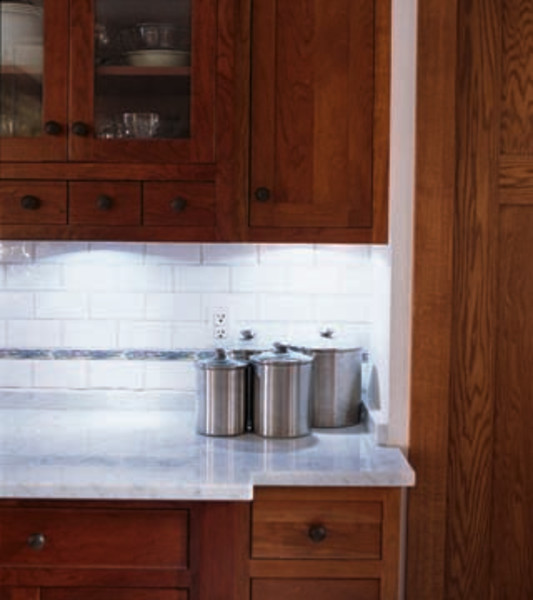Daily, use a damp cloth (or mop) without a cleaner.
Especially in the kitchen, marble is a high-maintenance material. Appropriate care will help avoid stains and the etching that causes dullness. Blot spills immediately with white paper towels or cloth (don’t wipe, blot). Flush with plain water and not too much mild soap and then rinse, and dry thoroughly. Daily, use a damp cloth (or mop) without a cleaner.
When you need to clean deeper, use products formulated for marble. Do not use any cleaning product containing lemon or vinegar. Do not use scouring powder or cream. Avoid commercial rust removers (for laundry or toilet bowls) as they may contain trace levels of hydrofluoric acid, which attacks marble. Don’t use clean-and-shine products as they contain oil or wax. Avoid polishes that include acrylic or polyurethane. Never, never mix ammonia and bleach, as it produces a toxic gas.
If the marble is sealed (which makes it stain-resistant, not stain-proof), follow your installer’s instructions for reapplication.
Removing new stains First, identify it—food, runoff from watering a plant, makeup? For water spots and rings, buff lightly with dry 0000 steel wool. For organic stains (coffee, fruit, paper), try 12% hydrogen peroxide and a few drops of ammonia. For oil-based stains including cooking oil or butter, milk, crayon, and cosmetics, try baking soda and water, or a mild liquid cleaner with a bit of bleach, or ammonia, or acetone. Do not mix solvents! Once the stain is dissolved you can flush it away. Such biological stains as algae can be cleaned with ½ cup ammonia in 1 gal. water. Or try bleach or hydrogen peroxide; do not mix. For ink on light marble, use bleach or hydrogen peroxide. On dark marble, use lacquer thinner or acetone. For smoke stains on a marble mantel, consider a commercial “smoke remover,” or call in an expert.
Using a poultice Any stain embedded in porous marble will need to be drawn out. A poultice is a liquid cleaner or chemical mixed with a white absorbent material to form a paste. As the slurry dries, the solvent that penetrated the stone is drawn back into the poultice, carrying the stain agent. The absorbent can be whiting or ground chalk, kaolin (clay), talc, Fuller’s earth, dry moulding plaster, tin oxide, plain tissues or white paper towels, cotton balls, gauze . . . though it’s preferable to buy a poultice powder from a stone dealer. For black or green marble, do not use a white-powder poultice; use white blotting paper.
Pre-wet the area around the stain to avoid its spread. (It’s best to use distilled water in every case.) Make the poultice ½” thick, extend it about an inch beyond the stain, cover it with plastic wrap, and leave it for 24–48 hours. (If the poultice dries too quickly, you can lift the plastic and spritz the poultice with water. You may want to tape down the plastic edges.) Remove plastic and allow the poultice to finish drying, then use a plastic spatula to scrape it away. Repeat if necessary (maybe multiple times). Finally, rinse with distilled water and buff with a soft cloth. If the solvent etched the surface, use polishing powder with a felt buffing pad.
The solvent to use varies by stain. For oil-based stains, try baking soda and water, or use acetone, naphtha, or mineral spirits. For organic stains, household ammonia or 20% hydrogen peroxide or acetone. For biological stains, diluted ammonia or bleach or peroxide (1/2 cup agent to 1 gal. water).
Tackling rust stains Home remedies require hard-to-purchase chemicals and several steps, so it’s best to use a commercially formulated rust-stain poultice. Or bring in a professional. Deep rust (iron, copper) stains may be permanent.
Stripping paint Small amounts may be removed with lacquer thinner or a sharp razor blade. Otherwise, use a standard (alkaline) solvent-based liquid stripper and wood or plastic scrapers. Do not use acid. Flush with lots of clean water. (As always, use rubber gloves, goggles, and plenty of ventilation.) Latex paint probably won’t leave a stain, though oil-based paint and putty may, which will need a poultice treatment. The stripper may etch the surface, requiring re-polishing.
Stain removal by poultice is cheap, easy, and effective. An absorbent (like powdered chalk) and appropriate cleansing agent are mixed to a paste and applied to the stain, which is drawn out of the stone into the poultice.
Marble Resources
Howard Granite and Marble Cleaner Non-acidic, non-abrasive formula for natural stone, quartz, porcelain & ceramic
MarbleLife Sealers and cleansers for marble and stone floors
MB Stone Care & Supply Full range of products including a spray cleaner, marble polishing powder & poultice pods
naturalstoneinstitute.org/consumers/care







